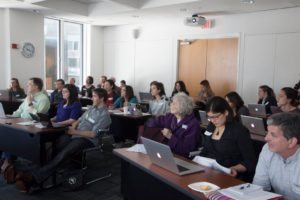
By Dylan McDowell
“Editing is a muscle. You need to exercise it, and it will get better.” That was the core message in the Hands-on Workshop on self-editing at this year’s Professional Development Day. The quote, by Lauren Morello of Nature, underscored how writers of all skill levels can apply a few tricks to submit polished pieces every editor will love.
First and foremost, get to know yourself as a writer. Most writers regularly exhibit the same mistakes such as skipping a quotation mark or using passive voice. The more aware you are of these shortcomings, the easier it will be to edit them out of your final version, the panelists said.
Frequent editing pitfalls for all writers are misusing similar words (e.g. then or than), misspelling names, and repeating conjunctions (such as and, but, or if). Science writers should be wary of getting lost in jargon and acronyms – after all, English is better than Latin.
To avoid these common mistakes, the panelists suggested writers walk away from a story for an acceptable amount of time and revisit it later with fresh eyes. Try reading your story backward, line by line, to slow your brain down and assess each sentence in isolation. Changing the font color or size will help bring new light to the piece. For kinesthetic writers, you can physically print out the story and use scissors to cut, edit, and rearrange key sections. If nothing else, use spellcheck. What seems like a simple trick is underused in the field.
Writers should be cautious of superlatives (e.g. first, last, or most) unless there is certainty, according to the panelists. If you’re unable to verify that something was actually the first, simply say “one of the first” or “one of the early” for safety. A time-saving tip is to highlight facts or figures when writing to guarantee you revisit them later.
Transitions were a focus of discussion for every panelist. The panelists suggested writers stay away from overused words and phrases like “meanwhile,” but also avoid beginning multiple paragraphs with the same line. The quickest test for this error is to read the first sentence of each paragraph in a story and see if it properly flows. Another trick is to choose one component of writing and highlight each instance to identify repetition. For example, highlighting every transition allows for easy analysis of whether you used the same word too many times. This same trick works for tracking adverbs, passive voice, and virtually any other common mistake. (See attached worksheet for the full activity.)
For those in search of more exercises to train their self-editing muscles, the book Writing Tools by Roy Peter Clark was suggested to take your editing to the next level. As Alysha Love of CNN Politics said on the panel, “Grammar is sexy,” and along with studies showing it will improve your dating life, it will make your editors very happy. Also check out this Editing Worksheet.

Sorry, comments are closed for this post.